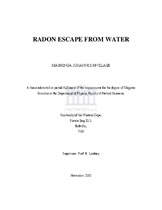| dc.contributor.advisor | Lindsay, Robbie | |
| dc.contributor.author | Mvelase, Mashinga Johannes | |
| dc.contributor.other | Dept. of Physics | |
| dc.contributor.other | Faculty of Science | |
| dc.date.accessioned | 2014-01-16T13:55:45Z | |
| dc.date.available | 2011/06/10 08:51 | |
| dc.date.available | 2011/06/10 | |
| dc.date.available | 2014-01-16T13:55:45Z | |
| dc.date.issued | 2010 | |
| dc.identifier.uri | http://hdl.handle.net/11394/2598 | |
| dc.description | Magister Scientiae - MSc | en_US |
| dc.description.abstract | This thesis aims to measure the rate of radon loss from water in a systematic way. The dependence on surface area, temperature and concentration will be investigated. The experiments were done at UWC by creating radon using radium sources and then measuring the radon concentrations inside a vacuum chamber to obtain the speed of radon escape from the water. The results are compared to a model [Cal 2002] where the radon concentration in the air and hence the transfer rate is measured using a RAD7 radon detector. Since the equations cannot be solved analytically, a numerical solution is employed. The radon transfer velocity coefficient is found to be (1.9±0.5)×10-6m/s. This value indicates that the escape of radon should not be a problem when a sample is open to the air for a minute or two. | en_US |
| dc.language.iso | en | en_US |
| dc.publisher | University of the Western Cape | en_US |
| dc.subject | Radon | en_US |
| dc.subject | Degassing | en_US |
| dc.subject | Transfer velocity | en_US |
| dc.subject | Ostwald coefficient | en_US |
| dc.subject | Radon detection | en_US |
| dc.subject | Pressure effects | en_US |
| dc.subject | Temperature effects | en_US |
| dc.subject | Alpha detection | en_US |
| dc.subject | Diffusion | en_US |
| dc.title | Radon escape from water | en_US |
| dc.type | Thesis | en_US |
| dc.rights.holder | University of the Western Cape | en_US |
| dc.description.country | South Africa | |

